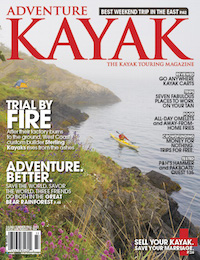It used to be when someone wanted to film an expedition or design a kayak, their avenue to success involved only sacrifice and determination. They might’ve saved money, quit their job and reached out to friends, family, sponsors or even the bank for financial support. Then they’d go out and humbly attempt to fulfill their dream. Except in the most audacious cases, the public was never privy to their project until after the fact.
People still do this today, but like most everything else in our ultra-connected, social networked world, the Internet is rapidly changing things. Take San Francisco-based paddler Anton Willis, who was inspired by origami as a way to make a folding kayak for storage in his apartment. He started with paper models and progressed to corrugated plastic signboard. After making more than 20 full-size prototypes he came up with a 12-foot light-tourer that folds up to the size of a sofa cushion.
Sensing his design had broader appeal, Willis made a pitch to the world on Kickstarter, a crowdfunding website, last November. Within weeks he raised over $440,000 in seed money from 730 backers, and his ORU Kayak was featured in Fast Company magazine and on CNN.
Willis is a poster child for the massive potential of Kickstarter, which launched to support independent “creative work” in 2009 and has generated over half a billion dollars in pledges to date. Aspiring entrepreneurs, inventors and creative-minded adventurers set a fundraising goal and deadline, pitch their idea in words and video, promote it on social media and hope for donations. The project is funded only if the entire goal is met. Backers act on faith and get nothing in return for their donation except for feel-good karma and perhaps a piece of memorabilia—or in the case of ORU Kayaks, discounted prices and first-run shipping for those willing to ante up the full cost of a new boat.
“We had initially looked for an angel investment but it seemed like people were put off by the [small] size of the market,” says Willis. “Kickstarter was a fantastic tool for us. It lets you tout a product and establish a niche market.”
Even with funding in place, Willis had only a moral obligation to deliver—such is the risk backers assume in supporting a crowdfunded project. Inevitably, this has led to several colossal flops, including a failed solo bike expedition in 2012 that wasted over $10,000 in sup- port. However, Alaska-based kayak-building enthusiast David Mi- chael Karabelnikoff says selling a dream to the world puts that much more emphasis on following through.
“It’s definitely taking a leap into the unknown in a public way,” says Karabelnikoff, whose Kickstarter campaign to develop a 3D printing process to rebuild traditional Arctic kayaks and inspire Native youth failed to reach its $25,000 goal in May. “As one of our early backers said, we threw everything we had into it and therefore no matter what the outcome we were committed, and will learn as a result.”
Of course, relying on Kickstarter isn’t an excuse for lazy planning and execution. Portland, Oregon-based sea kayakers Jason Self, Chris Bensch and Shay Bickley raised nearly $11,000 through Kickstarter to fund The Search for the Perfect Day, a series of paddling and filming expeditions to California, Florida and Hawaii that will evolve into a video series. “ The 30-day Kickstarter campaign took several years of strategic planning to execute properly,” says Self. “We had thousands of contacts and several sponsors at the ready with thousands of their own followers to receive our requests. Without this in place we never would have met our goal.
“I can’t say that the Kickstarter process was enjoyable…raising money is hard, hard work. As my boss said after he saw the bags under our eyes, it would have been easier to get another real job.”
This article first appeared in Adventure Kayak, Early Summer 2013. Download our free iPad/iPhone/iPod Touch App or Android App or read here for free.



